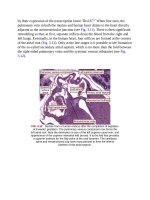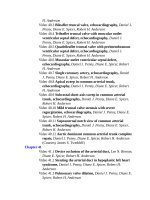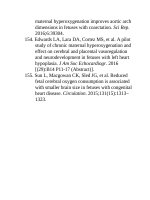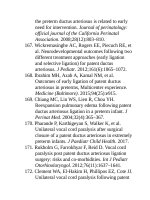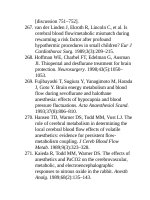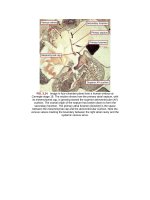Andersons pediatric cardiology 1846
Bạn đang xem bản rút gọn của tài liệu. Xem và tải ngay bản đầy đủ của tài liệu tại đây (134.95 KB, 3 trang )
concordantconnections(e.g.,hypoplasticleftheartsyndrome).Forthese
neonatestherearetwosurgicaloptions,Norwoodpalliationandsocalled
“hybridpalliation.”
TheNorwoodprocedureincludesarchreconstruction,aDKStyperoot
amalgamation,creationofanonrestrictiveatrialseptaldefect,andplacementof
anappropriatelyrestrictivesourceofpulmonarybloodflow—eitheramodified
Blalock-Taussigshuntorashuntfromtherightventricletothepulmonaryartery
(Fig.71.5).89TheNorwoodprocedurerequirescardiopulmonarybypasswitha
periodofaorticcross-clampingandperfusiontechniquesthatallowforaortic
archreconstruction.Thisremainsoneofthehigher-riskprocedurescommonly
performedinthenewbornperiod.90–93
FIG.71.5 (A)Norwoodprocedurewithasystemic-to-pulmonaryartery
(Blalock-Taussig)shunt.(B)Norwoodprocedurewithaconduitfromthe
rightventricle(RV)tothepulmonaryartery(PA).Ao,Aorta;IVC,inferior
venacava;LPA,leftpulmonaryartery;PV,pulmonaryvein;SVC,superior
venacava;TV,tricuspidvalve.(FromBarronDJ,BrooksA,SticklyJ,etal.
TheNorwoodprocedureusingarightventricle–pulmonaryarteryconduit:
comparisonoftheright-sidedversusleft-sidedconduitposition.JThorac
CardiovascSurg.2009;138[3]:528–537.)
Thehybridprocedureisanalternativethatprovidesforneonatalpalliation
includingbandingofthebranchpulmonaryarteriesandmaintenanceofthe
arterialductwitheitherastentoraprostaglandininfusion(Fig.71.6).94,95Ifnot
present,anonrestrictiveatrialseptaldefectiscreatedusinginterventional
catheter-basedtechniques.Theadvantageofthehybridprocedureisthatisdoes
notusecardiopulmonarybypass.Definitivemanagementofleftventricular
outflowtractobstructionandarchhypoplasiainvolvesaNorwood-style
reconstructioncombinedwiththesecond-stageprocedure.96Someprogramsuse
thehybridprocedureforallneonateswithfUVHandseverearchhypoplasia.
Thisavoidsalongperiodofcardiopulmonarybypassinthevulnerableneonate.
Otherprogramsreservethisalternatestrategyforpatientswithriskfactorsfor
cardiopulmonarybypassincluding;prematurity,lowbirthweight,infection,
necrotizingenterocolitis,andintracranialhemorrhage.Thedisadvantageofthe
hybridprocedureisamorechallengingperiodbetweenneonatalpalliationand
thecomprehensivesecond-stageprocedure,includingthepredictableneedfor
catheter-basedreinterventiondirectedattheatrialseptumornarrowingbetween
thestentedarterialductandthemoreproximalaorticarch,referredtoas
retrogradearchobstruction.97,98Inaddition,thesecond-stageprocedureismore
complicatedandrequiresalongperiodofcardiopulmonarybypassforarch
reconstructionandreconstructionofthebandedpulmonaryarteries.96Atpresent
thedecisionbetweentheNorwoodprocedureandthehybridapproachremains
largelyprogram-specificwithoutanobviousadvantagetoeitherprocedureinthe
average-riskneonate.
FIG.71.6 Thehybridprocedurecombinesbandingofthebranch
pulmonaryarteryandmaintenanceofthearterialduct.Thiscanbe
accomplishedwithaprostaglandininfusionforshort-termpatencyorwitha
stent.Inaddition,anonrestrictiveatrialseptalcommunicationmustbe
created.(FromBarronDJ,KilbyMD,DaviesB,etal.Hypoplasticleftheart
syndrome.Lancet.2009;374[9689]:551–564.)
SurgicalTechnique.
TheDKSisperformedthroughamediansternotomyincisionusing
cardiopulmonarybypass.PatientssuitableforanisolatedDKSdonothavearch
obstruction,andprofoundhypothermiaisnotnecessary.Aftercross-clamping
andcardioplegia,ananastomosis—generallywithpatchaugmentation—ismade
betweenthegreatvesselsabovethesinotubularjunctionofthesemilunarvalves.
Therearetwogeneraltechniques.Inthefirstthepulmonaryrootistransected
abovethesinotubularjunctionandaverticalincisionismadeintheascending
aortaadjacenttothepulmonaryroot.Theadjacentproximaledgesoftheaorta
andpulmonaryrootarejoined,andtheremainderoftheconnectionis
accomplishedwithapatch.Thesecondtechnique,sometimescalledthe“doublebarreled”technique,involvescompletetransectionofbothgreatvesselsabove
thesinotubularjunction.Thegreatvesselsarejoinedattheir“kissing”pointand
theascendingaortaisthenanastomosedtothisdouble-barreledroot.Patch
augmentationisfrequentlyrequiredtomakeforthesizediscrepancybetween
thecombinedrootandtheascendingaorta.Asourceofpulmonarybloodflowis
necessary.Intheneonatewithasingleleftventricle,thiswillbeasystemic-topulmonaryarteryshunt.Inaninfantthatwassuitablypalliatedwithapulmonary
arteryband,abidirectionalsuperiorcavopulmonaryanastomosiscanbe
performed.
TheNorwoodprocedure(Video71.1)isperformedthroughamedian
sternotomywithcardiopulmonarybypass.Afterinitialdissection,thepatientis
cannulatedforcardiopulmonarybypass.Arterialcannulationisachievedby
cannulatingeitherthepulmonaryartery,arterialduct,orusinganePTFEgraft
anastomosedtotheinnominateartery.Singlevenousorbicavalcannulationcan
beusedforvenousreturn.Oncecardiopulmonarybypasshasbeenestablished,
flowtothepulmonaryarteriesispreventedbysnaringeitherthebranch
pulmonaryarteriesortheductusarteriosus.Threeperfusionstrategieshavebeen
describedfortheperiodofarchreconstruction;deephypothermiccirculatory
arrestat18°C,antegradecerebralperfusionatdeephypothermiaat18°Cto
22°C,orcontinuousperfusionatmoderatehypothermia.Thelastapproach
